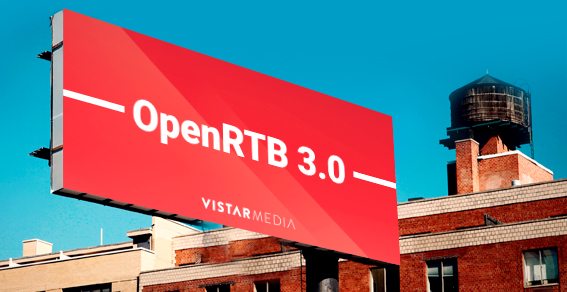
We need to proceed with purpose to protect the unique nature of OOH.
When the Interactive Advertising Bureau (IAB) Tech Lab released the newest version of the standards that define programmatic transactions, known as the OpenRTB 3.0 specifications, it was the largest overhaul of RTB since the start in 2010. And significantly, for the first time the revamped bidding guidelines expanded to include digital out of home (DOOH). So, a defined programmatic spec is coming to our medium.
Why should the OOH world care?
DOOH can already be purchased today via a biddable auction in both open and private marketplaces – a real, true programmatic experience. Yet less than 5% of DOOH is bought programmatically. Thanks to the rise of mobile location data –enabling DOOH to be targeted and measured in the same manner as other digital media channels –the adoption of programmatic is accelerating. Akin to digital advertising, advertisers will be able to employ their data assets to make planning and buying decisions and more accurately understand the ROI of OOH.
The adaptation of OpenRTB for OOH is an indicator of the next phase for programmatic as the largest omnichannel demand-side platforms – companies such as Verizon Media – work to bring OOH fully into their systems. Just as the mobile and video industries progressed, this is a necessary step and requirement for going deeper into programmatic strategies and large-scale budgets.
This has implications if the OOH industry doesn’t move fast to protect the unique nature of OOH and proceed with a shared vision for a programmatic future for the OOH industry. There is a ton of opportunity to command investment, if channels can meet and exceed digital expectations and requirements. This requires moving the OOH channel in line with the rest of the digital media world, but there are three key steps that I believe the industry must take in order to succeed.
Prevent fraud before it starts.
The online ad industry is full of fraud. OOH has been fortunate to avoid this issue. We should maintain this by putting in place adequate safeguards to ensure that buyers don’t, for example, end up placing a banner ad onto a small part of a large OOH screen. This may sound like an exaggerated example, but I’ve heard actual discussions in our industry about how to capture exactly this type of “accidental demand” from display advertisers. At worst this could be considered fraudulent, but even at best would result in a terrible experience for the brand and the end consumer. Losing sight of the unique nature of OOH placements undermines the scale and impact that makes OOH desirable for advertisers in the first place. Let’s keep all types of fraud out, not let it in.
Protect the impression currency.
The OOH industry has spent millions on research and developing datasets so advertisers can understand the eyeballs with the opportunity to see an OOH ad. Between industry standards from Geopath and Nielsen to detailed exposure methodologies developed by media owners and 3rd-party providers, our industry has successfully solved for the intricacies inherent in this 1-to-many medium. Media owners transact all of their direct and current programmatic business against this currency. OpenRTB should be implemented by DSPs in a way that can support this one-to-many currency, so that media owners are properly paid for their inventory and we do not devalue the medium.
Properly align with campaign goals.
OpenRTB is simply a schema for systems to communicate. It does not address campaign strategy, planning or measurement. A significant part of OpenRTB transactions in the online ad ecosystem are lower-funnel, performance campaigns. They are looking for clicks and conversions online. We must be careful not to lump ourselves into strategies and measurement requirements that do not align with the strengths of our channel. Beyond brand metrics, OOH is also an amazing driver of in-store visits for large retailers and product sales for some of the largest CPG and automotive brands. Measurement capabilities exist that can demonstrate that impact, and as an industry we should invest in developing those further and avoid being evaluated on online action metrics where OOH will perform poorly.
The OOH industry will no doubt follow in the footsteps of digital and mobile, and move increasingly to standardized OpenRTB transactions, as we work to help the OOH industry fit better into a digital marketer’s arsenal. The future of OOH is brighter than ever. Bridging the digital online ad ecosystem with the existing programmatic OOH growth will lead to a well standardized, easy to access, and scalable media opportunity for marketers.
Published: September 12, 2019